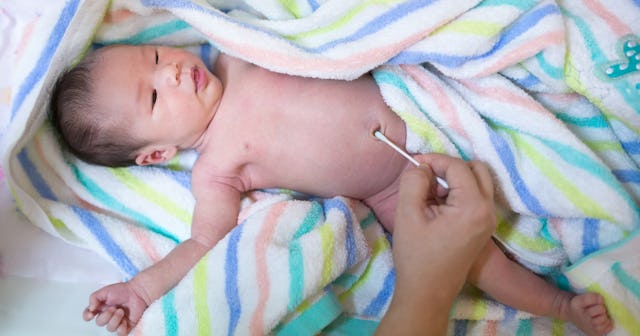The New Parent's Guide To Caring For Your Baby's Belly Button (& Stump!)

We’re just going to come right out and say it: Newborn baby belly buttons are weird. Well, not once their umbilical cord stump falls off and they look like normal human belly buttons. Before that. Like, when they still have the stump and you can’t take your eyes off of it because, yes, you want to make sure they get the proper care but are also kinda fascinated by their alien body part — plus, simultaneously a little grossed out by this particular piece of your precious baby. It’s a lot for a new mama to process! And that’s to say nothing of baby belly button care, which makes the entire newborn naval situation all the more perplexing.
Still not sure what exactly is going on down there? Consider this your guide to newborn belly button care, including how to clean it, and what to do if it’s bleeding or you suspect that it’s infected.
Looking for more baby care tips? We have pages on baby bonding, bow-legged babies, “am I ready for a baby” quote page, and more.
RELATED: How to Clean Baby’s Nails
What’s the deal with a baby belly button?
If you’ve given birth, been present at one, or even just watched a scene including one on TV, then you’re familiar with the part when the new baby’s umbilical cord is clamped and snipped. This results in a stump which starts drying out and eventually falls off in one to three weeks. As a new parent, you may be tempted to pull the stump off yourself (read: you will definitely be tempted to do so). As tempting as it may be, though, resist the urge to pull or pick at that stump, Mama. It may look gross, but it’ll fall off on its own schedule. What you can — and should — do during those first few weeks is keep the stump dry, including by sticking to sponge baths.
Is baby belly button bleeding normal?
A little bit of bleeding around the stump isn’t anything to worry about. And, much like a scab, it’s possible for the stump to bleed a small amount when it falls off. But if the area around their belly button oozes pus, develops a pink moist bump, or if the surrounding skin becomes red and swollen, it could be an infection. In that case, you’ll need to take your baby to the doctor.
What does a newborn belly button infection look like?
Although rare, there is a life-threatening infection called omphalitis that can happen right before a newborn baby’s stump falls off. In that scenario, a trip to the emergency room is warranted. The symptoms include signs of an infection, such as:
- pus
- redness or discoloration
- persistent bleeding
- bad smell
- tenderness on the stump or belly button
How do you clean a baby belly button?
It’s important to keep a newborn baby’s umbilical stump dry, as well as clean. But instead of washing it regularly, do what you can to keep it from getting dirty. And because the stump falls off once it’s dry, keep the stump from getting and staying wet. If the stump does end up getting wet, gently pat it dry using a clean baby washcloth. A cotton swab is also an option, but make sure that you don’t rub or poke the stump too aggressively, so it doesn’t fall off before its time. As we mentioned above, sponge baths are the way to go while the stump is still around.
Once the stump detaches from your newborn baby’s little body, keeping their belly button clean is relatively straightforward. You can start giving them regular (non-sponge) baths, during which you just need to use the edge of a washcloth to gently clean inside the belly button. Just don’t scrub too hard or use soap. And there’s no need to clean a baby’s belly button any more frequently than they bathe. That’s basically it! Well, you know, besides breathing a big sigh of relief once the stump finally falls off.
What causes an outie belly button?
It’s not hard to tell whether you have an innie or an outie, but this section is for all the babies with outies out there. Contrary to popular belief, the way an umbilical cord is cut has nothing to do with the kind of belly button a person has (mind blown!) Outies aren’t caused by hack jobs done by clumsy doctors. They are completely normal and more common in premature babies and children with low birth weight. They’re usually caused by an umbilical hernia and heal on their own. Outies are also formed by excess scar tissue, which causes a navel to poke out.
What is a baby belly button hernia?
An umbilical hernia is pretty common. This is when the child’s intestines seep through the abdominal wall, inside where the belly button is. It may look unusual, but it isn’t painful or a threat to a baby’s health. Umbilical hernias usually go away at ages four to five. However, if it lingers longer, some doctors may suggest surgery.
Can your belly button absorb liquid?
Pouring water into a belly button will not cause the stomach to fill with water. Although belly buttons cannot absorb liquids, they can take in the scents of oils. Some people rub essential oils in and on their belly button to help relieve menstrual cramps, bloating, and other digestive issues. There isn’t any proven science behind this, but if you’re thinking about giving it a shot, just check in with your doctor beforehand.
This article was originally published on